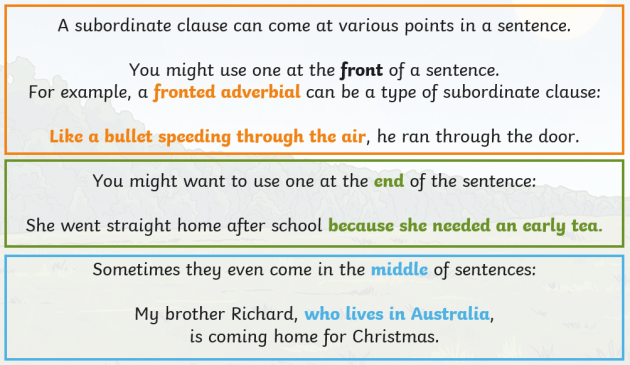

A subordinate clause is a group of words in a sentence that contains a subject and a verb but cannot function as a complete sentence on its own. It depends on an independent clause for its full meaning.

To understand what subordinate clauses are and how we define a subordinate clause, it's useful to take things back to basics and look at what we mean by the term clause.
Clauses are the building blocks of sentences. A clause is a group of words that contain a subject (a noun or pronoun) and a verb (a doing word).

A subordinate clause is a clause that can't stand alone as a complete sentence. It's linked to a main clause using a subordinating conjunction. It doesn't express a complete thought and requires additional information if read on its own.
You might also be wondering, well, what is a dependent clause? In fact, a dependent clause is exactly the same as a subordinate clause. They're just two different names for the same thing.
For example, in the sentence 'I played out until it went dark', the phrase 'until it went dark' is the subordinate clause because it requires additional information in order to make sense. Subordinate clauses contain a subject noun and a verb.

When a sentence contains a sub clause, we call it a complex sentence or a multi-clause sentence. You can remember some of the most useful conjunctions by using the acronym 'I SAW A WABUB'.
Subordinate clauses can act as adverbs, adjectives, or nouns (which we will explore in more detail below). They complement a sentence’s main clause, adding to the overall unit of meaning. Subordinate clauses can also help establish the time sequence, causality, or a specific example of the idea.
Whether you use the term subordinate or dependent to describe this type of clause, the clause’s function remains the same: it provides additional information to support the main event of the sentence.
Subordinate clauses can be found at the start, the middle, and the end of a sentence.
In the first and third examples, 'sitting happily' is the subordinate clause. In the second, 'who was busy laying eggs' is the subordinate.
You may also notice that when your subordinate clause is in the middle of a sentence, it's separated by commas. This type of subordinate clause is embedded in the sentence.
You might notice that the embedded examples use the relative pronouns 'who' 'that' or 'which'. Sometimes, we can remove them from the dependent clause to make the writing flow more smoothly.
Take a look at these dependent clause examples without the relative pronoun:
Once we know how subordinate clauses work and how to form them, we can play with the rules and remove the relative pronouns. This helps to make our writing flow in a more natural way. This is especially helpful for activities such as creative writing!
There are three types of dependent clauses: adverb clauses, adjective clauses (also known as relative clauses) and noun clauses. As you might've guessed, they involve adverbs, adjectives and nouns. Each one is a type of subordinate clause where the clause acts as either the adverb, adjective or noun.
A subordinate clause that acts as an adverb (where it modifies a verb) is an adverb clause. This type of clause is usually used with these conjunctions:
Here are some examples:
Just like an adjective, an adjective clause adds information to a noun or pronoun in a sentence. This type of subordinate clause starts with a relative pronoun: that, who, whom, whose or which. It's also called a relative clause.
In some cases, the relative pronoun can be dropped from the clause (if it still makes sense afterwards). Then, it's called a contact clause.
You guessed it: a noun clause acts like a noun. This type of clause starts with that, what, whatever, who, whom, whoever, or whomever.
When a noun clause uses 'how', it can be called a 'how' clause.
Learning how to find a dependent clause in a sentence will deepen your pupils' understanding of this grammar topic as a whole. If they can find a dependent clause accurately and correctly, it means they understand what makes up a subordinate clause and how they function in a sentence.
So, what is the best way to find a dependent clause in a sentence?
First, you should look for the subordinating conjunctions. If the sentence includes if, since, as, when, although, while, after, before, until or because, there's a good chance that the clause including and following the conjunction is a subordinate clause.
To find the relative clause, you should look for a relative pronoun - i.e. does the clause start with who, whom, whose, which, where or that?
Finally, the best way to find a dependent clause is to break the sentence into separate clauses and see which ones make sense on their own and which ones don't.
By nature, subordinate clauses depend on another clause to make sense. So if you pull out a clause that doesn't express a complete thought and can't stand on its own as a sentence, it's pretty much guaranteed that it's a dependent clause.
Figuring out how to join two dependent clauses is tough - because it's impossible!
As we've already established, subordinate clauses don't express a complete thought. They can't stand alone as a sentence and they depend on another clause to be grammatically correct and to create meaning.
However, the second clause can't be another subordinate clause. While they're both dependent, they can't depend on each other.
Here's what happens when you try to join two dependent clauses:
Although we can gather some meaning from this sentence, it's awkward to read and doesn't quite make grammatical sense. There's no independent clause for the two subordinate clauses to depend on and draw meaning from.
We would need to add an independent clause to fully realise the meaning of this sentence:
The independent clause 'she was late' clarifies the meaning of the sentence and gives some context for the other two dependent clauses. Two dependent clauses can be used in the same sentence, as they are here, but they still need to work alongside an independent clause.
Phrases and dependent clauses are similar in some ways, which means they can be confused. However, the two are distinctly different from each other.
To understand the difference, it's helpful to go back to the basic definitions of phrases and clauses.
So, a phrase doesn't contain a subject and verb, while a dependent clause does. This is the key difference between the two of them.
A dependent clause can be directly joined to another clause and it will make sense. However, a phrase needs to be added into a clause or alongside a clause to make sense.
Here's an example of a phrase:
Here's an example of a dependent clause:
As you can see, the phrase is a part of the dependent clause.
We need to add this to a main clause for it to make sense:
Here are some more examples to further explain the difference between phrases and dependent clauses.
| Phrase | Dependent Clause | Sentence | Explanation |
| in the middle of the night | where the stars were shining | In the middle of the night, she looked where the stars were shining. | The phrase 'in the middle of the night' sets the scene. The dependent clause 'where the stars were shining' gives extra detail. The phrase is added alongside the clause. |
| having no other option | when the clock struck 3 | Having no other option, he packed and left when the clock struck 3. | The phrase 'having no other option' also sets the scene, explaining the reason for his actions. The dependent clause explains 'when' the event happened. The phrase is added alongside the clause. |
| delicious chocolate cake | where there was delicious chocolate cake | They walked over to the buffet where there was delicious chocolate cake. | The phrase 'delicious chocolate cake' is added into the dependent clause. |
| thrashing, angry waves | because of the thrashing, angry waves | The boat was close to capsizing because of the thrashing, angry waves. | The phrase 'thrashing, angry waves' is also added into the dependent clause. |
Teaching children about subordinate clauses is an excellent way of improving their reading and writing skills. A solid understanding of how subordinate clauses work enables children to read more complex texts and add extra detail to their own writing.
If you'd like to help your child or class understand more about “what is a subordinate clause”, take a look at the teacher-made resources below: